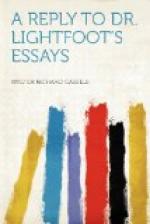Apart from the question of the sufficiency of evidence actually under examination, however, I have never suggested, much less asserted, that the “Acts of the Apostles” was not in existence at this date. The only interest attachable to the question is, as I have before said, the paucity of the testimony regarding the book, to demonstrate which it has been necessary to discuss all such supposed allusions. But the apologetic argument characteristically ignores the fact that “many took in hand” at an early date to set forth the Christian story, and that the books of our New Testament did not constitute the whole of Christian literature in circulation in the early days of the Church.
I need not go with any minuteness into the alleged quotation from the fourth Gospel. “There shall come a time in which whosoever killeth you will think that he doeth God service.” The Gospel has: “There cometh an hour when,” &c., and, as no source is named, it is useless to maintain that the use of this Gospel, and the impossibility of the use of any other, is proved. If even this were conceded, the passage does not add one iota to our knowledge of the authorship and credibility of the Gospel. Dr. Lightfoot says “The author of Supernatural Religion maintains, on the other hand, that only twelve years before, at the outside, the very Church to which Irenaeus belonged, in a public document with which he was acquainted, betrays no knowledge of our canonical Gospels, but quotes from one or more apocryphal Gospels instead. He maintains this though the quotations in question are actually found in our canonical Gospels.” [144:1] Really, Dr. Lightfoot betrays that he has not understood the argument, which merely turns upon the insufficiency of the evidence to prove the use of particular documents, whilst others existed which possibly, or probably, did contain similar passages to those in debate.
VII.
TATIAN’S ’DIATESSARON.’
I need not reply at any length to Dr. Lightfoot’s essay on the Diatessaron of Tatian, and I must refer those who wish to see what I had to say on the subject to Supernatural Religion. [145:1] I may here confine myself to remarks connected with fresh matter which has appeared since the publication of my work.




